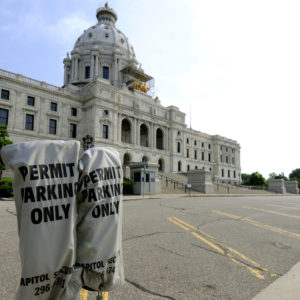The principle of separation of powers is central to the American republican form of government. At both the state and federal level, the executive, legislative, and judicial branches balance their powers and responsibilities against each other. While they frequently struggle towards incompatible goals, the system is intended to force compromise. In Minnesota, however, this balance has been dramatically upset, after Democratic Governor Mark Dayton used his line-item veto authority to reject the legislature’s budget on the last day of a special session earlier this year. On Monday, the case was heard before the Minnesota Supreme Court, which is set to decide is the governor has the authority to strip the legislature of its $130 million, two-year budget.
Minnesota state law grants the governor the authority to veto line item spending that he disagrees with when signing a bill. Prior to Dayton, no governor had attempted to use that power to force the state legislature to heel. Before the Minnesota Supreme Court, the state legislature argued that this was an attempt to usurp the power of the legislative branch, effectively abolishing it.
“The governor understood (the veto) would put the Legislature out of business for the next two years unless it bent to his will,” the brief said. “By depriving the Legislature of funding, the governor has prevented the Legislature from performing its core functions.”
However, finding legal justification for blocking the veto is more difficult. The text of the state law does not limit the governor’s veto authority. Dayton had quibbled with state lawmakers over tax cuts in a massive budget bill they sent to his desk. With the session waning, he opted to exercise his veto and sent the legislature home, without any time to draft an alternative. The new session will not begin until February.
“The Governor did disagree with the appropriation because he said we have these remaining issues, and your work is not done,” Sam Hanson, Dayton’s lawyer, said.
State politics observers are already concerned about the dangerous precedent the case sets, regardless of how it is decided. When the legislature opted to sue the governor, they essentially granted the Minnesota Supreme Court final decision-making authority over the power of the purse. This has already happened at a county level during state government shutdowns after a Ramsey County court ordered that certain essential government functions continue to be funded. (Ramsey County includes St. Paul, the state capital.)
However, during the questioning, Chief Justice Lorie Gildea seemed hesitant to wade into the question of whether the court had the authority to order funding.
“Here Governor Dayton is violating this bedrock doctrine [of separation of powers] willy-nilly: he is trying to use his executive power to legislate, while denying the legislature’s core legislative function, and is tempting the court to use its judicial authority to legislate by appropriating funds,” writes Kim Crockett, vice president and general counsel for the Center of the American Experiment, a state think-tank.
“Do you see why such a scheme results in chaos, and opens future negotiations to devolve into one long bicker fest?” she continued.
Dayton appointed four out of the seven justices on the Minnesota Supreme Court, but few think that will have much impact on the court’s final decision.
In an interesting twist, cameras were allowed inside the courtroom. As a result, interested citizens were able to watch the arguments and questioning through a live video feed on the State Supreme Court’s website. Previously, cameras had been allowed inside the courtroom on a case by case basis, but under a two-year pilot program that began in 2015, cameras were allowed inside the courtroom, with the recordings posted online afterward. The opening arguments in the legislature’s case were the first time that the Supreme Court livestreamed a hearing.
Supporters of the move said that it would help boost public confidence in the court and promote transparency.
“By livestreaming our oral arguments, we hope to give more Minnesotans the opportunity to see their highest Court in action, and to learn more about how our Court considers and decides the important legal matters that come before us,” said Gildea in a statement.
So far it has helped to keep the bizarre case in front of voters. Despite the publicity, Dayton remains confident that his curious political ploy was wise. Before the arguments, Dayton said in an interview that, regardless of what the court rules, he considers history to be the final judge of his actions and expressed confidence that he had acted within his authority as governor.
“I’ve done my utmost to conduct myself honorably in the office,” said Dayton, whose second and final term concludes at the end of 2018. “People may disagree with our policies, but I hope people believe I have acted in the best interests of Minnesota, and that I have conducted myself within the legal authority provided me.”

